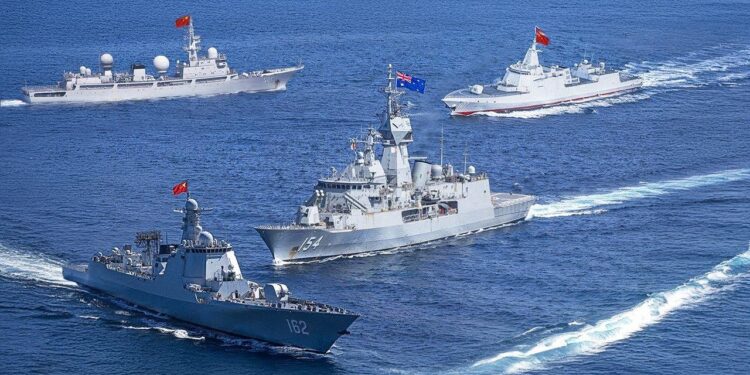In a significant development in regional maritime dynamics, Chinese warships have embarked on their inaugural foreign visit to Bangladesh following the establishment of the interim government. This historic visit underscores the growing naval cooperation between the two nations and highlights Bangladesh’s strategic importance in the Indo-Pacific corridor. Observers note that the arrival of the Chinese fleet not only reflects deepening defense ties but also serves as a signal of the shifting geopolitical landscape in South Asia. As both countries navigate their roles in an increasingly complex security environment, this visit is poised to have implications for regional stability, defense partnerships, and trade relations.
Chinese Warships’ Historic Visit to Bangladesh Reflects Rising Naval Cooperation and Strategic Alliances
The recent arrival of Chinese warships in Bangladesh marks a pivotal moment in the evolution of regional maritime dynamics. This historic visit, being the first foreign military endeavor since the interim government assumed power, demonstrates an increasing alignment between Dhaka and Beijing amid rising geopolitical tensions. The joint exercises and goodwill initiatives underscore Bangladesh’s strategic pivot towards enhancing its naval capabilities while also drawing closer to key partners. Observers note that this development is not merely about military camaraderie but also reflects deeper economic ties and a shared vision of stability in the Indo-Pacific region.
The presence of the Chinese fleet signifies more than just a naval visit; it represents a bold step towards fostering multilateral cooperation in addressing regional security challenges. As both nations navigate the complexities of their respective defense strategies, this partnership could facilitate access to advanced naval technology and training programs essential for modernizing the Bangladesh Navy. Furthermore, it reflects broader aspirations to ensure maritime security, protect vital trade routes, and enhance mutual interests in a rapidly shifting international landscape. In light of these developments, the implications of this alliance deserve careful attention as they may reshape the security dynamics within South Asia.
Implications of Military Ties: What the Arrival of Chinese Naval Forces Means for Bangladesh’s Defence Strategy
The arrival of Chinese naval forces marks a pivotal moment in Bangladesh’s military landscape, driven primarily by strategic alliances and regional security concerns. This development may prompt a reevaluation of Bangladesh’s defense strategies, particularly in its relationship with neighboring countries. A burgeoning partnership with China could enhance technological access and support for naval capabilities, ushering in potential benefits such as:
- Modernization of naval assets: Upgrading the fleet with advanced technologies and equipment.
- Joint exercises: Engaging in cooperative operations to strengthen interoperability and tactical proficiency.
- Increased military support: Receiving military aid and training programs, fostering a more robust defense framework.
However, the implications of strengthening ties with China extend beyond mere military enhancement. There is a growing concern that such partnerships may affect Bangladesh’s diplomatic relations with other regional powers, particularly India and the United States, potentially leading to a realignment of alliances in South Asia. The increased presence of Chinese naval forces in local waters could prompt neighboring countries to recalibrate their own defense postures to counter perceived threats, instigating a delicate balance of power. Key considerations for Bangladesh’s defense strategy may include:
- Maintaining sovereignty: Ensuring that military cooperation does not compromise national autonomy.
- Strategic neutrality: Navigating relationships carefully to avoid being seen as aligning too closely with any one power.
- Enhancing regional cooperation: Fostering dialogues with neighboring nations to address mutual security concerns.
Recommendations for Strengthening Bangladesh’s Maritime Security Amid Increased Regional Engagement
As regional dynamics shift and foreign engagements intensify, Bangladesh must prioritize comprehensive measures to bolster its maritime security infrastructure. Enhanced collaboration with both neighboring and global maritime powers can prove instrumental in addressing potential threats and ensuring safe navigation of trade routes. Key strategies should include:
- Strengthening naval capabilities: Investing in advanced naval assets and technologies to enhance surveillance, reconnaissance, and response capabilities.
- Regional partnerships: Fostering multilateral exercises and joint operations with countries like India, Myanmar, and ASEAN nations to build interoperability among navies.
- Intelligence sharing: Establishing robust intelligence-sharing mechanisms with regional partners to effectively counter transnational maritime threats, including piracy and smuggling.
In addition to military enhancements, the government should focus on fostering marine domain awareness and building resilient infrastructure along the coastline. Public-private partnerships can promote innovation in maritime security technologies, while educational programs can raise awareness and train personnel in maritime law enforcement. To structure the approach, Bangladesh might consider creating a dedicated Maritime Security Task Force with an integrated command center to coordinate national efforts and resources. Below is a table summarizing potential initiatives:
| Initiative | Description |
|---|---|
| Naval Upgrades | Acquisition of advanced warships and surveillance drones. |
| Joint Exercises | Conducting regular naval drills with ally nations. |
| Community Awareness | Launching educational campaigns on maritime issues. |
The Conclusion
In conclusion, the arrival of Chinese warships in Bangladesh marks a significant milestone for both nations, indicating a strengthening of ties amidst a complex geopolitical landscape. As Bangladesh continues to navigate its foreign relations under the interim government, this visit may serve as a pivotal moment for enhancing military cooperation and strategic partnership with China. Observers will be keen to see how this development influences regional dynamics, particularly in light of historical maritime disputes and the ongoing influence of major powers in South Asia. As the global focus on military alliances and diplomatic relations continues to shift, the implications of this visit cannot be understated. The situation remains fluid, and further developments will be closely monitored by analysts and policymakers alike.














Italy to Deport Egyptian Imam After Controversial Comments at Pro-Palestine Rally